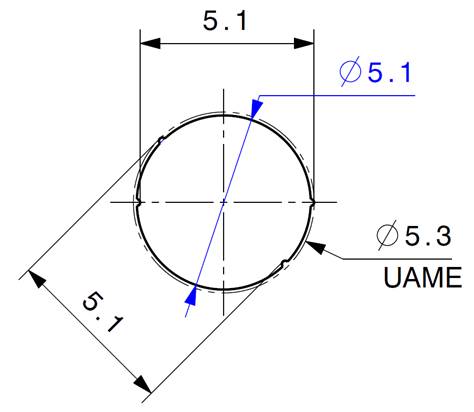semiond said:
For 4-30(a) - I thought about a width feature of size symmetrical to the part axis, 30 mm wide and +- toleranced, the right side only defined as B datum feature. But probably it's not a very good example now that I think of it, because it doesn't meet the requirement of the standard to have a basic location between all datum feature simulators. There would be a basic zero implied to the center plane, but no basic dimension to the side face defined as datum B. Still something about the exclusive dependency on profile of a surface tolerance being specified for the behavior of the simulator to be defined - bothers me, rightfully or not. That is in addition to the more important fact that it's not entirely according to para 4.5.2.
I assume the directly tolerance width 30 would have to be controlled with a position tolerance relative to datum A. If we take, for example, that the width size tolerance is +/-0.1 and the position tolerance is 0.3(M) wrt A, this means that the MMB of datum feature B (one face of the width) with respect to A is 15.2 = (30.0+0.1+0.3)/2. So the datum feature simulator B has to progress from 15.2 towards LMB of datum feature B until maximum possible contact with actual surface B is achieved. I do not see anything incorrect in this description provided that we agree/realize that para. 4.5.2 does not do good job in terms of description of all possible behaviors of datum feature simulators that one can imagine/define.
semiond said:
Based on the text of para 4.5.2(c), I would think that the behavior dictated by fig. 4-31(b) always applies. Do you share this opinion?
Yes, this conclusion could be drawn. But, as I have been trying to point out and as shown in figs. 4-30(a) and 4-31(a), this is not always true.
semiond said:
As for the example from that website, I don't see how the mobility of datum feature simulator C in [Y] can help to constrain [w] and nothing else. But that is not the point.
The important points in my opinion are:
1. Datum feature simulator for datum feature C is not allowed to be movable at all, according to para. 4.5.2 (c).
2.Unlike in fig. 4-46 where no other datum feature sets a particular orientation for the 4 faces of the square tab simulator around it's "axis" (centerplanes intersection), in this example datum feature B simulator must be basically oriented to datum feature C simulator (around all axes, as I understand), and therefore according to para. 4.5.2 (b) is not allowed to rotate as suggested by the author.
Essentially this leaves the CDRF concept inapplicable for the given example. Am I mistaken?
Yes to #1. Although I have to admit that it may look rather weird that on one hand I say that translation of datum feature simulator C is not allowed because para. 4.5.2 says so, but in the other aspect, that is mobility of datum feature simulator B in figs. 4-30(a) and 4-31(b), I claim that the same paragraph cannot be followed ;-)
As for #2, I am not sure I see a problem with the rotation of datum feature simulator B. Datum feature simulator B is not allowed to rotate relative to datum feature C (or I should rather say the opposite) in |A|B| DRF. This basically controls mutual location and orientation of both datum features relative to each other**. However, in the customized DRF, simulator B is allowed to rotate relative to C.
** The problem with the example is that since both holes have been also controlled with profile to A, they are subject to simultaneous requirement and the simultaneous requirement controls their mutual orientation and location in the first place. To me this makes usage of position tolerance for hole C at least questionable.
P.S.: Looks like the discussion about CDRF concept and related figures hijacked the thread a little bit (maybe even more than a bit). If you don't mind, semiond, I would like to bring it back to the right track. So could you please start new thread if you want the CDRF topic to be further explored? Thank you.


![[ponder] [ponder] [ponder]](/data/assets/smilies/ponder.gif)
![[sad] [sad] [sad]](/data/assets/smilies/sad.gif) ). The total allowed form error is 0.2. In the second scheme, if the note PERFECT FORM AT MMC NOT REQUIRED wasn't included, the two cases were the same but the cylindricity tolerance would be redundant. Sorry for the bad example
). The total allowed form error is 0.2. In the second scheme, if the note PERFECT FORM AT MMC NOT REQUIRED wasn't included, the two cases were the same but the cylindricity tolerance would be redundant. Sorry for the bad example ![[blush] [blush] [blush]](/data/assets/smilies/blush.gif)